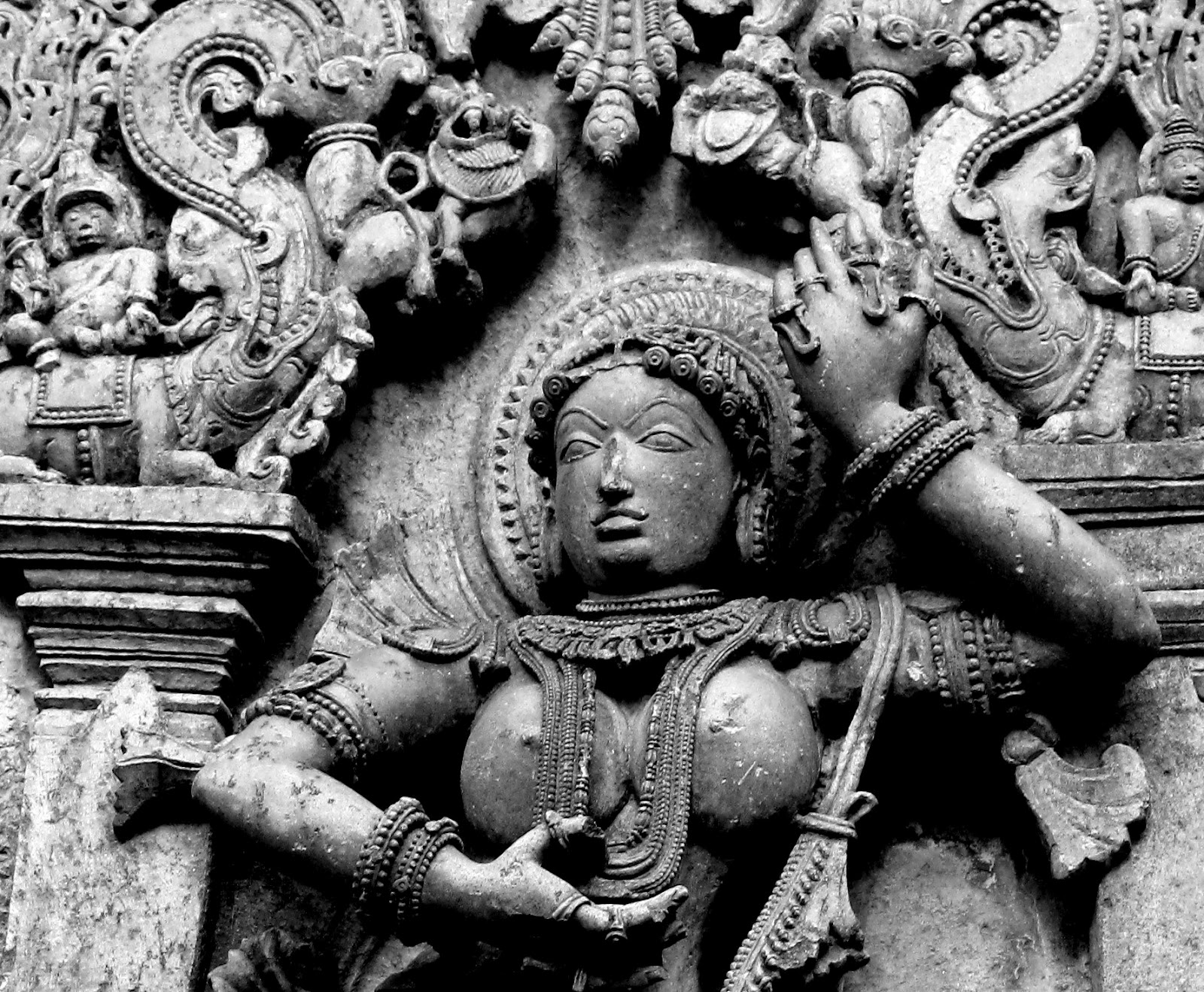“This is the most famous sculpture of the Chennakeshava temple,” says the guide, pointing at a voluptuous dancer, etched in the ceiling of the entrance. “Shantala, King Vishnuvardhana’s main queen, built the surrounding spaces of this temple. She was a genius at mathematics and a gifted dancer and musician.” The details, as far as our eyes, shaded from the sharp sun, can see, are astoundingly minute, created patiently by a talented sculptor working with soapstone. From the folds of her jewel-encrusted mini dress, to the leaves of the flowering tree that encompass her, and the way that she stands, her hedonistic body shaped S with a Barbie-thin waist, the sculptor’s imagination is vivid and full of grace. Even though she holds a mirror, in front of her, her face is more thoughtful than vain. Shantala’s figure comes repeatedly in the world famous Belur temple, in Karnataka, one of the finest creations of the Hoysala Kingdom, built in 1117 CE. Her legends have been immortalized in a book by KV Iyer called Natyarani Shantala, which was also televised recently.
The story goes that she was the talented daughter of a general in the Hoysala kingdom. She used to be such a good dancer that the Chalukya king threatened the Hoysala kingdom with a war, just to see her dance (for she would have to offer a sacred dance at the Lakshmi temple before the war). When King Vishnuvardhana first saw her dance, planned meticulously by his grandmother so he would fall for the girl and marry, he instantly fell for her. She refused the marriage, since both she and her best friend Lakshmi had danced together and she was a Jain while the king was a Vaishnava. To appease her, the king married not only her and Lakshmi, so they stay together as co-wives, but also five other girls from the same community. And he also let her keep her faith. King Vishnuvardhana made her his main queen, and she helped him in the administration of the kingdom as well as building temples around their capital city of Belur.
However, not everything was all right. Even after many years of marriage, she couldn’t produce a male heir for the kingdom and though she requested multiple times, her husband refused to denounce her and take on Lakshmi who was pregnant at the time, as his main queen. To get out of the way of her pregnant best friend and the husband she loved, she killed herself by jumping off Shivaganga, a tall hill near Bangalore, ruled by men and monkeys together.

The rigourous climb to the top of Shivaganga, takes about two hours, twisting and turning through vertically steep rocky climbs, high rising stonewalls and natural edged turns. As you climb, your city lungs scream and a group of monkeys stare down at you, sometimes menacingly, sometimes nonchalantly. At present, since it’s a tourist spot, there are railings to protect and aid you, but in 1131 CE, when Shantala, her heart torn by the fact that she couldn’t conceive, took this path, there were none. I imagine her going all the way up, beyond the monolithic Nandi and the customary temple on top, and in calm determination, heading to the edge of a deep gorge, still called Shantala drop. For a second perhaps she hesitated breathing in the panoramic valley view beneath, before she took the final step, plunging down the steep mountain to her death.
Shantala’s suicide is also contested by some. Another legend says that she didn’t kill herself but took the Jain vow of sallekana, of self-starvation to achieve nirvana to become a saint and guide her community in generations to come. We would never know the truth, as she hasn’t left any spoken or written legacy behind her.
“She’s the goddess who protects the Belur temple,” says a confidant in Belur’s marketplace, “Even though the Mughals tried to destroy the temple and the government doesn’t care too much about it, she continues to protect it for future generations.” And so a dancing girl became a queen and then Shantala Devi, a goddess who protects temple ruins. As I walk around the empty halls of Belur’s astounding marvel, I’m glad that the work of art still stands for us to take pleasure in. And silently I thank her.
Published in Discover India September 2015.


Hi Shweta,
Very good initiative to write about Shantala Devi one who is a hidden Diamond.
thanks Ashwini. I loved her folk legend too.
Wow. That was an interesting Write Up.
Thanks for taking time to read and comment, Vikas!